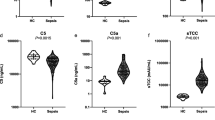Abstract
The time courses of serum complement levels and the severity of sepsis were compared in two groups of septic patients, one in which the patients survived (surviving group) and one in which they did not (nonsurviving group). The components of the complement system, namely, C3a, C4a, C5a, CH50, C3, C4, and C5, were measured at several points in time after the diagnosis of sepsis had been established. A 2-antibody radioimmunoassay was used to measure C3a, C4a, and C5a; the latex agglutination test was used to measure C3 and C4; nephelometry was used to measure C5; and Meyer's 50% hemolysis method was used to measure CH50. Following the diagnosis of sepsis, the levels of CH50, C3, and C4 were significantly lower in the nonsurviving than the surviving group, while the levels of C3a and C4a were significantly higher in the nonsurviving than the surviving group. The C5a levels were significantly higher in the nonsurviving than the surviving group, although no significant intergroup differences were subsequently noted. These results suggest that the serum levels of C3a, C4a, C5a, CH50, C3, and C4 could serve as indices of the severity of sepsis. Thus, monitoring the complement system may be useful for predicting the outcome of patients with sepsis.
Similar content being viewed by others
References
Kane MA, May JE, Frank MM (1990) Interaction of the classical and alternative complement pathway with endotoxin in lipopolysaccharide. J Clin Invest 52:370–376
Leon C, Rodrigo MJ, Tomasa A, Gallart MT, Latorre FJ, Rius J, Brugues J (1982) Complement activation in septic shock due to gram-negative and gram-positive bacteria. Crit Care Med 10:308–310
Sprung CL, Schultz DR, Marcial E, Caralis PV, Gelbard MA, Arnold PI, Long WM (1986) Complement activation in septic shock patients, Crit Care Med 14:525–528
Nakae H, Endo S, Inada K, Takakuwa T, Kasai T, Yoshida M (1994) Serum complement levels and severity of sepsis. Res Commun Chem Pathol Pharmacol 84:189–195
Langlois PF, Gawryl MS (1988) Accentuated formation of the terminal CSb-9 complement complex in patient plasma precedes development of the adult respiratory distress syndrome. Am Rev Respir Dis 138:368–375
Hack CE, Nuijens JH, Felt-Bersma RJF, Schreuder WO, Eerenberg-Belmer AJM, Paardekooper J, Thijs LG (1989) Elevated plasma levels of the anaphylatoxins C3a and C4a are associated with a fatal outcome in sepsis. Am J Med 86:20–26
Chenoweth DE, Hugli TE (1980) Techniques and significance of C3a and C5a measurement. In: Future perspectives in clinical laboratory immunoassays. Nakamura RM, Alan R (eds) Liss, New York, pp 443–460
Gorski JP (1981) Quantitation of human complement fragment C4a in physiological fluids by competitive inhibition radioimmunoassay. J Immunol Methods 47:61–73
Dofferhoff AS, deJong HJ, Bom VJ, van der Meer J, Limburg PC, de Vries-Hospers HG, Marrink J, Mulder PO, Weits J (1992) Complement activation and the production of inflammatory mediators during the treatment of severe sepsis in humans. Scand J Infect Dis 24:197–204
McCabe WR (1992) Serum complement levels in bacteremia due to gram-negative organisms. New Engl J Med 288:21–23
American College of Chest Physicians/Society of Critical Care Medicine Consensus Conference Committee (1992) Definitions for sepsis and organ failure and guidelines for the use of innovative therapies in sepsis. Crit Care Med 20:864–874
Cavaillon JM, Fitting C, Haeffner-Cavaillon N (1990) Recombinant C5a enhances interleukin-1 and tumor necrosis factor release by lipopolysaccharide-stimulated monocytes and macrophages. Eur J Immunol 20:253–257
Scholz W, McClurg MR, Cardenas GJ, Smith M, Noonan DJ, Hugli TE, Morgan EL (1990) C5a-mediated release of interleukin-6 by human monocytes. Clin Immunol Immunopathol 57:297–307
Huey R, Hugli TE (1985) Characterization of a C5a receptor on intact human polymorphonuclear leukocytes (PMN). J Immunol 135:2063–2068
Alexander JW, McClellan MA, Ogle CK, Ogli JD (1976) Consumptive opsoninopathy. Ann Surg 184:672–678
Author information
Authors and Affiliations
Rights and permissions
About this article
Cite this article
Nakae, H., Endo, S., Inada, K. et al. Chronological changes in the complement system in sepsis. Surg Today 26, 225–229 (1996). https://doi.org/10.1007/BF00311579
Received:
Accepted:
Issue Date:
DOI: https://doi.org/10.1007/BF00311579




